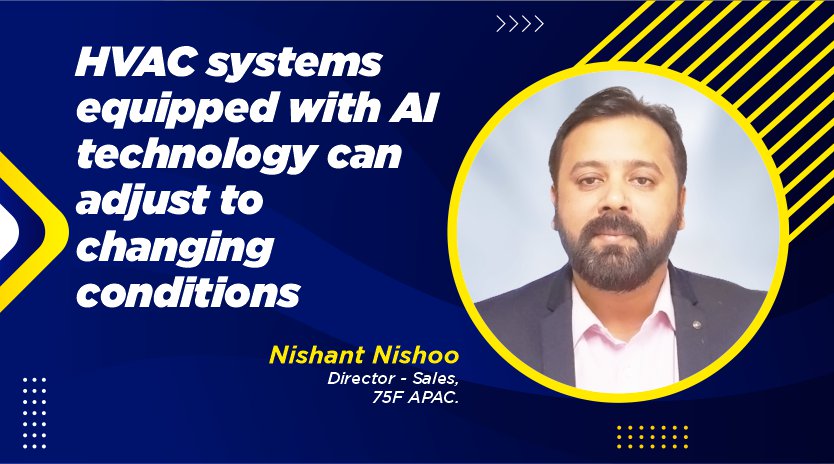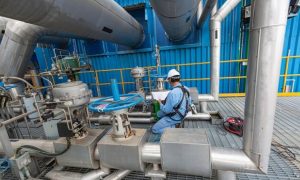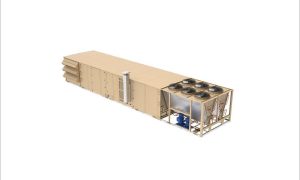AI monitors inputs and adjusts parameters, allowing HVAC systems to monitor and execute various other tasks, says Nishant Nishoo, Director – Sales, 75F APAC.
New opportunities in built environments in the area of thermal comfort
Feeling comfortable in an interior space directly impacts people’s moods. Working in optimal settings allows us to think and perform better, and thermal comfort in office buildings adds to well-being and productivity. Eliminating potential health hazards is critical to maintaining optimal thermal comfort. Given below are some emerging opportunities in thermal comfort areas in built environments.
Integrating HVAC and acoustic solutions: Acoustic ceilings are the interaction between building services and equipment in conventional buildings (HVAC, lighting, etc.), often covering 80%–90% of the floor space from wall to wall. In recent years, there has been a surge in the use of hydronic heating and cooling systems based on lightweight radiant panels. If the ceiling is still completely covered, the coverage ratio of sound absorbers is often reduced to 40%–70% of the ceiling surface as the ceiling also accommodates the radiant panels.
Thermally activated building systems: For thermal transfer considerations, the ceiling in buildings with concrete core cooling—also known as Thermally Activated Building Systems (TABS)—must be covered to allow energy to move between the room and the concrete slab. It can, nevertheless, benefit from room acoustic optimisation.
AI to enhance BMS monitoring in HVAC systems
The role of artificial intelligence (AI) is to receive data from the BMS System, process it, and advise the existing HVAC system on how to run more intelligently and efficiently. Building structures outfitted with building management systems (BMS) are becoming more dynamic and responsive to occupants. AI analytics can help improve BMS platform functions in three ways: analytics built into the platform, analytics embedded in equipment, and additional analytics software designed to supplement specific building operations such as energy management, comfort control, or predictive maintenance.
Emerging BMS monitoring and access control solutions for regulating HVAC systems Recently, technologies such as AI and IoT incorporated into building management are constantly evolving and transforming the air conditioning sector. Listed are some emerging technologies that regulate the HVAC systems:
Smart thermostats: Homeowners can connect HVAC equipment with other house parts using smart home technologies. A 75F Hyperstat, a recent addition to our product portfolio, is the most advanced thermostat and humidistat currently on the market, thanks to its eight integrated sensors and industry-leading connections. The HyperStat also has software defined control capabilities for freestanding, multistage, and modulating HVAC equipment, including PTAC units, heat pumps, and fan coils in typical commercial buildings. It also has six relays, four analogue inputs, three analogue outputs, and four analogue outputs
Intelligent techniques to minimise risks: Building operations are routinely automated with BMS. Using data for business decisions, proactive monitoring, and building operations management is made possible by having a single integrated infrastructure of property data. Businesses might find revenue possibilities by investing in integrated BMS to maximise the value of linked systems Portable Interface: Many users and stakeholders in property management use a BMS, an extensive data ecosystem. Therefore, offering a user-friendly and practical mobile interface or a separate application for consumer convenience is essential. Several crucial functions, such as communications and remote control, can help streamline property administration.Custom Reporting: Instead of contacting tenants or contractors to obtain paperwork, some BMS software includes document storage and a management unit that automates reporting through predefined inquiries and follow-ups.
Challenges in using BMS for monitoring and maintenance of HVAC
Smart technologies are increasingly used in buildings to create a connected and futuristic experience. This is followed by the generally held belief that smart facilities must be built from the ground up, as retrofitting old structures to become smart facilities is complex and inefficient. A well-planned strategy and the appropriate technology platform can quickly assist facility managers in converting traditional buildings into smart buildings.An intelligent building investment eventually pays for itself by allowing for better productivity, lower operating expenses, and more significant planning opportunities. It takes time, money, and understanding to implement IoT and grasp how to benefit from an intelligent building.
AI technology as the subsequent transformation in HVAC control
Multiple sensors provide controllable (temperature, humidity, etc.) and uncontrollable (weather condition, occupancy status, etc.) inputs to the HVAC system. AI is constantly monitoring these inputs and adjusting parameters, allowing the HVAC system to monitor several parameters, specify set points, turn units on and off, and execute various other tasks. All this occurs completely autonomously—no energy efficiency manager is required. When any environmental parameter changes, such as weather, occupancy, or energy use, the HVAC control immediately regulates itself .An HVAC system equipped with AI technology can adapt to changing conditions. An AI-based solution processes real-time data from sensors and modifies the system automatically rather than manually. Modern HVAC control systems based on artificial intelligence algorithms provide substantial benefits to all parties.

Advantages of implementing AI technology in HVAC systems
AI systems can convert raw data from sensors to actionable insights that can save money, improve efficiency, and reduce environmental effects on businesses. Herein are some advantages of having AI in HVAC systems Controls for HVAC: Controlling an HVAC system is complicated as building conditions change frequently. Any change in the outdoor temperature influences the amount of heating or cooling necessary to maintain a comfortable and steady inside temperature. Ventilation and temperature controls are also impacted as personnel arrive and exit the premises. The numerous indoor activities have an impact on the HVAC requirements, too. An intelligent control system may evaluate these data in real time and adjust the HVAC system as needed.Ventilation Systems: External airflow must be considered while optimising ventilation systems. More heat is necessary to maintain an optimum home temperature if outdoor airflow increases during winter. Although air handlers use less energy than space heaters and air conditioners, the external airflow of a structure determines its heating and cooling requirements. Over-ventilation wastes energy, whereas under-ventilation harms indoor air quality.The AI-enabled ventilation system can monitor the number of inhabitants and the number of air contaminants while determining the necessary airflow to maintain an ideal living atmosphere. The most important rule of any sound ventilation system is never to restrict airflow below the minimum value required by building codes.
Heating and cooling in the workplace: According to a study by the Lawrence Berkeley National Laboratory (LBNL), an interior temperature of 22 degrees Celsius promotes human productivity. During the investigation, it was discovered that any change in the temperature-induced discomfort reduced productivity. While extreme temperatures are infrequent, indoor air quality suffers as temperatures deviate from the optimal range. Energy savings can be realised by upgrading outdated equipment, such as chillers, boilers, space heaters, air conditioners, and other HVAC equipment with built-in AI.
Measures to Improve Energy Efficiency: Airside economisers and energy recovery ventilation (ERV) are AI’s most efficient HVAC modifications. Airside economisers help to save energy in a variety of conditions. Airside economisers promote ventilation and reduce the need for air conditioning when the outside air temperature and humidity are within the appropriate range. Savings are attainable as ventilation fans consume less energy than air conditioners do.By controlling the external airflow, energy recovery ventilation eliminates any waste for heating or cooling.
AI techniques enhance occupants’ comfort
One or more systems (e.g., central HVAC system, ceiling fan, desk fan, etc.) are frequently responsible for delivering thermal comfort to building inhabitants. While thermal comfort varies from person to person and over time, these systems are commonly operated based on predefined setpoints and schedules of operations or at the request/routine of each individual. This causes discomfort for the occupants and wastes energy.
Cookie Consent
We use cookies to personalize your experience. By continuing to visit this website you agree to our Terms & Conditions, Privacy Policy and Cookie Policy.















